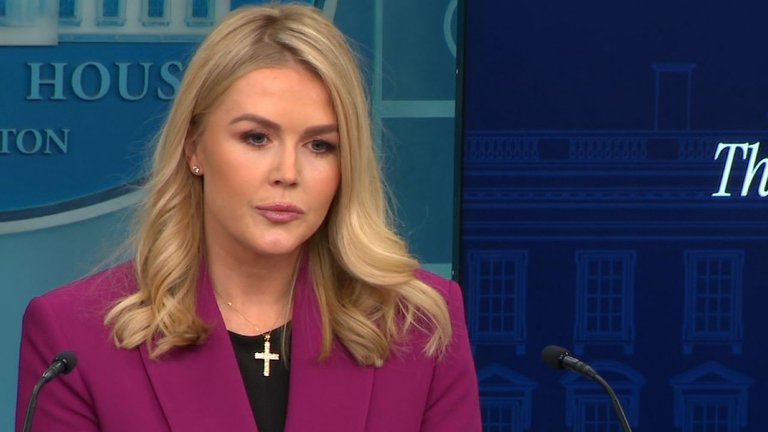The inaugural press briefing of Karoline Leavitt, the youngest White House Press Secretary in U.S. history at just 27 years old, marked a significant shift in the Trump administration’s approach to media and public engagement. Held at the White House, the briefing set a new tone, emphasizing inclusivity in media access and transparency on pressing national issues. Here’s a comprehensive look at the highlights and implications of her first address.

- A New Era of Media Inclusivity
Karoline Leavitt began the briefing by announcing a groundbreaking change in the administration’s media policy. Over 400 press passes that had been revoked under stricter guidelines were reinstated, signaling a commitment to restoring traditional press freedoms. Beyond this, the administration is opening its doors to bloggers, podcasters, and social media influencers.
Leavitt emphasized that this decision was meant to diversify the voices represented in the briefing room, providing access to smaller, independent outlets alongside mainstream media giants. She noted, “The American people deserve a wide variety of perspectives, not just those from legacy institutions.” This move has already drawn praise from independent journalists and criticism from traditional media outlets concerned about losing prominence.
- Addressing the Medicaid Portal Freeze
One of the most urgent topics covered during the briefing was the temporary freeze of the Medicaid benefits portal, which sparked confusion and concern across the country. Millions of Americans rely on Medicaid, and the sudden inability to access the portal raised fears about delayed benefits.
Leavitt reassured the public, stating that no payments were affected during the outage. She explained that the freeze was part of a broader audit of federal spending, including programs such as Social Security, Medicare, and student loans. While the administration framed the audit as a necessary step toward reducing waste and inefficiencies, critics have voiced concerns about its potential impact on vulnerable populations.
- The Mystery of New Jersey Drone Sightings
Another unexpected issue discussed during the briefing was the recent spike in drone sightings over New Jersey, which had left residents puzzled and concerned about their purpose.
Leavitt clarified that the drones were authorized by the Federal Aviation Administration (FAA) for recreational use and posed no threat to public safety. President Trump, she added, had been briefed on the matter and directed the FAA to ensure transparency in such activities to avoid unnecessary panic.
This response was aimed at calming fears while showcasing the administration’s proactive approach to addressing localized concerns.
- Shaping the Narrative Through Media Strategy
The Trump administration’s relationship with the press has long been contentious, and Leavitt’s first briefing made it clear that this dynamic would continue. She prioritized questions from non-mainstream outlets like Axios and Breitbart News, signaling a willingness to engage with media platforms aligned with the administration’s perspective.
Notably, the inclusion of independent journalists and influencers in the press pool reflects a strategic effort to bypass traditional media gatekeepers and reach audiences directly through alternative channels. This approach is consistent with President Trump’s reliance on social media during his previous term, where direct communication with the public was a hallmark of his presidency.
Leavitt’s assertive demeanor during the briefing mirrored Trump’s combative style. She did not shy away from challenging reporters, demanding accurate reporting while vowing to uphold the administration’s commitment to transparency.
- Leavitt’s Historic Role and Early Impressions
At 27, Karoline Leavitt’s appointment as White House Press Secretary has drawn significant attention. A rising star within conservative circles, she has previously worked as an aide to prominent Republican leaders, including President Trump. Her rapid ascent to this role has been both celebrated as a sign of generational change and critiqued for her limited experience in dealing with the national press corps.
Her debut performance was marked by confidence and control. Analysts have described her approach as a blend of youthful energy and seasoned political savvy, underscoring her potential to shape the administration’s messaging effectively. However, her direct and occasionally combative tone has also raised questions about whether this approach will foster a productive relationship with the press or further escalate tensions.
What Lies Ahead
Karoline Leavitt’s first briefing has set the tone for the Trump administration’s second term. By broadening media access, addressing public concerns directly, and adopting a no-nonsense approach to media relations, Leavitt has signaled a departure from traditional press secretary norms.
Her tenure will likely be defined by her ability to navigate a polarized media landscape while maintaining the administration’s commitment to its core base. Whether her strategies will prove effective in bridging the divide between the White House and the press remains to be seen, but her debut has undoubtedly left an impression.
As the youngest Press Secretary in U.S. history, Karoline Leavitt has embraced the challenges of her role with a boldness that reflects the administration’s broader goals: to disrupt the status quo, amplify diverse voices, and engage directly with the American people. Her journey will be one to watch in the coming months as she continues to define her role and its impact on the Trump administration’s legacy.